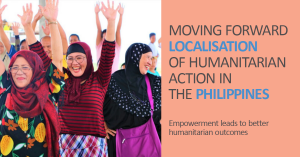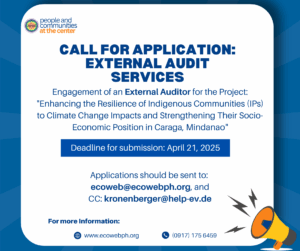The Indigenous Peoples and IPRA
In February 1987, the Filipino people ratified what is later known as the 1987 Philippine Constitution, the first fundamental law of the Philippines that recognizes the ancestral rights of indigenous peoples (IP) in the country since western imperial dominion powered over the archipelago in 1521. For 466 years before 1987, the indigenous peoples, who comprised a vast majority of the Philippine population upon the arrival of the Spanish explorers in the country, lost their rights over their ancestral domains and lands. From March 1987 to the present, the IPs have continued to face an uphill legal struggle in their claim of what is left of their ancestral domain and lands.
A decade after the ratification of the 1987 Philippine Constitution, 24 years ago today, on October 29, 1997, the Republic Act No. 8371 or the Indigenous Peoples Rights Act (IPRA) was passed into law by the Philippine Congress. Since then, the indigenous peoples have encountered improvements and challenges in their lives as a direct and indirect consequence of IPRA.
Up to the present, there is still no reliable data on the population of IPs in the Philippines. The population census conducted in 2010, for the first time, included an ethnicity variable yet no official figure for Indigenous Peoples’ population has been released. The country’s Indigenous population continues to be estimated at between 10% and 20% (10.1 to 20.2 million) of the national population of 100,981,437, based on the 2015 population census. Some put the estimated IP population at 14 million by end of 2019.
Certificate of Ancestral Domain Title (CADT)
The estimated 110 indigenous tribes in the Philippines have occupied about 7.7 million hectares or 26% of the 30 million hectares total land area of the country. Thanks to IPRA, as of April 30, 2019, the National Commission on Indigenous Peoples (NCIP) has issued 243 Certificate of Ancestral Domain Titles (CADT) covering a total land area of 5,735,893.1072 hectares and recognized a total of 1,314,419 IPs as rights holders or about 9.39% of the total estimated IP population in 2019.
The titled IP lands are roughly 74% of the estimated 7.7 million hectares occupied by the IPs. But the IP rights holders are just about 9% of the estimated 14 million IP population. These imply that about 91% of the IPs in the Philippines are either living in the remaining untitled 26% of IP lands or areas still to be recognized as IP lands or cannot be covered by the provisions of IPRA. Most of these unrecognized IP lands and domains are now populated by non-indigenous peoples or within government reservations.
The majority of the issued CADT (55%), CADT with the biggest area (52%), and CADT with the highest number of IP holders (59%) are located on the island of Mindanao. The remaining challenge of this issued CADT is their registration with the Land Registration Authority (LRA). Over 70% of the issued CADTs in Mindanao are not registered with the LRA primarily due to the pending issuance of Certificate of Non-Overlap (CNO) by the Department of Environment and Natural Resources (DENR) and the Department of Agrarian Reform (DAR) following the Joint Administrative Order No. 01 series of 2012 signed by DENR, DAR, LRA, and the NCIP.
Challenges in Working with IP Communities
Since its inception in 2006, the Ecosystems Work for Essential Benefits, Inc. (ECOWEB) has been working with indigenous peoples particularly among the Higaunons, Kalibugan, Subanen, and Manobo tribes. ECOWEB has supported the processing of CADT for at least 5 ancestral domains and currently working for the resource management of 3 ancestral domains (AD) – one with approved CADT and two with an ongoing application since 2006.
In the 3 ancestral domain areas where ECOWEB is currently working, mineral claims such as Mineral Production Sharing Agreements (MPSA) and Exploration Permits cover not less than 40% of the total areas some of which are approved and waiting for further mining development.
In the last 5 years, a common trend in all the 3 ancestral domain areas is emerging: the waiving by and transferring of land rights by IPs to non-IPs. Interestingly, this is more rampant in the AD with approved CADT but not yet registered with the LRA.
In consultation with IP community of the Higaunon tribe in Binasan, Rogongon, Iligan City, the phenomenon was explained by Datu Junny Mahunyag, one of the IP leaders in the area:
“We never intend to sell our ancestral lands because it does not belong to us alone. We co-own it with our ancestors and the grandchildren of our grandchildren. We only wish to develop and generate income from our lands. We invited investors but no one commits because our properties do not have documents and they don’t trust us because we are IPs. A few, mostly miners, wanted to mine our lands but we are reluctant to agree with their offered terms. We hope to develop out lands other than mining but no one commits to invest. But when we said we are willing to waive our rights of ownership and donate it for token amounts, many came and offer a good amount! That’s why many are tempted to waive their rights, virtually selling their lands. A few good investors are interested in a joint venture under usufructuary terms – one kind of investment we are hoping.”
Developing Ancestral Domains
The development of ancestral domains is not only within the mandate of NCIP but also of other agencies like the Department of Environment and Natural Resource (DENR), the Department of Agriculture (DA), and the Department of Social Welfare and Development (DSWD) and other agencies. But because these agencies are not IP-focus, often the IPs have to compete with non-IP groups and communities in accessing development support and services from these agencies. Developing titled ancestral domains and lands is a real challenge even more challenging than acquiring the CADT. In most cases, the NCIP is only capable of assisting IP communities in the formulation of their Ancestral Domain Sustainable Development and Protection Plan (ADSDPP).
Titling ancestral domains and lands follows well-articulated provisions in the IPRA and succeeding NCIP administrative orders. When it comes to the development of ancestral domains, titled or not, there is no single law that guarantees such support. In the CADT application process, IPs are talking about their customary laws and their lands, and the government provides funds to support the process. During its development phase, when the IPs are already talking about funding needed, not in thousands but millions, yet no budget is allocated. The problem is where to get that funding. NCIP does not have the necessary budget for ancestral domain development.
NCIP Budget
The NCIP in 2021 has three main programs: 1) Ancestral Domain/Land Security and Development Program, 2) Human, Socio-economic, and Ecology Development and Protection Program and 3) Indigenous Peoples Rights Protection Program. The first program focuses on the titling and development of ancestral domains. This is the program that is supposed to support the development of titled ancestral domains.
For 2021, the NCIP was allocated with a budget of ₱1.137 billion or only .025 % of the total 2021 approved national budget of ₱4.506 trillion. Of the approved NCIP budget, ₱588,489,000 or 52% is allotted for its operations. 21% of the operational budget or ₱125,290,000 or just 11% of the overall NCIP budget is allocated for ancestral domain securitization and development program that supports the titling process and the formulation of Ancestral Domain Sustainable Development and Protection Plan (ADSDPP) for both titled and under-processing applications.
Rising frustration over titled domains with no development support
The trend where IPs intend to sell or waive the rights over their land is a concrete manifestation of the urgency for support in the development of their ancestral domains. This could be a manifestation of their frustration that after securing titles of their domain they are helpless in developing it for their children.
“If only the government or the rich people partner with us in developing our lands, no IP will waive his right because it is not just us who own it. It belongs to us, our ancestors’ and our grandchildren. We have no right to sell our land. But we need to survive, we need capital to develop our land and the only way to do it is to sacrifice some portion of it so that we can develop the others,” said Datu Junny Mahunyag.
In an effort to protect the IPs, the NCIP released National Advisory No. NA-2020-08-01 s. 2020 entitled “To Stop, Prohibit and Report any Transaction, Dealing, Negotiation of Selling and Transfer of Lands within the Ancestral Domain” sometime in August 2020.
“That is a commendable move of the commission however, it should be accompanied by an all of government effort,” says Kevin Fernan, the Project Manager of ECOWEB’s Formation of Production Guild for Social Enterprise for Economic Development of Indigenous Communities (FPG-SEEDIC). “Our effort to partner with PhilFIDA in enhancing the production capacity of abaca farmers is one way of supporting the expressed need of the IPs. More IP abaca farmers have been trained and provided with planting materials while we focus on the capacity building of the production guilds. If other government agencies would lend their helping hands, I believe, we could achieve more.”
ECOWEB, for its part, after helping the Higaunons of Iligan secure their CADT in 2017 after more than 10 years of effort, responded to the request of the members of the Indigenous Political Structure (IPS) to help them in their abaca farming and trading. ECOWEB developed the concept of the FPG-SEEDIC project that gets support from the Germany-based Bread for the World. At present, the project is being implemented in the Bayug-Iligan and Bayog Zamboanga ancestral domain areas. It resulted in the formation of 22 fully organized and 12 formative production guilds with a total membership of 768 farming families and 1,432 individual members of which 52% are men and 48% women.
One production guild in Iligan City hinterland already started their indigenous people’s social enterprise in March this year and has marketed more than 3,000 kilograms of abaca fiber produced by its members valued at more than ₱200,000 or a monthly average gross income of ₱33,000 within the first 6 months of its operation. Another production guild that started last year has already sold more than 3 million pesos worth of abaca fiber produced by their members.
In Bayog, Zamboanga del Sur, ECOWEB is helping the Subanens of Bayog, Zamboanga del Sur in setting up social enterprises where their expected royalty fee from a mining company operating within their ancestral domain could be invested.
“It is a very challenging mission to support IPs develop their domains,” explained Regina Antequisa the Executive Director of ECOWEB. “ECOWEB intends to enhance the IP capacity to establish and manage social enterprises that are based on their experience and culture. The IPs chose an enterprise centered in abaca farming and trading because abaca is a crop very familiar to them. We thought it was easy but it was not. The urgent need of most IPs is for their daily survival. Many have difficulty in developing their abaca farms because they have to work for daily wage somewhere to provide for the daily needs of their families. We tried to mobilize support from government agencies and international agencies. We successfully got support from the Germany-based Bread for the World for funding but government agencies’ support have been limited mainly to technical support and encouragements with some support for seedlings and few pieces of equipment.”
The need for an all-of-government approach in developing ancestral domains
Most of the IPs think that only NCIP is the government agency that is mandated to help them and they felt frustrated because most of their needs are not within the remit of NCIP. On the other hand, NCIP officers also felt helpless in responding to the needs of the IP communities, their allocated budget by congress is just too limited.
“Helping the IPs develop their ancestral domains demand a whole-of-government approach but sadly, this is only happening in areas where the insurgency is strong and the IPs are participating,” laments Ms. Antequisa. “The approach of the government in mobilizing resources from various agencies through the coordination of the Task Force End Local Communist Armed Conflict (TF-ELCAC) is good but it should not be confined as an anti-insurgency strategy. This approach could be done by ELCAC-like local task forces where the NCIP could lead. If the government could allocate up to 20 million pesos for IP barangays affected by the armed conflict, why can’t this be done in other IP barangays?”
The challenge of supporting indigenous peoples’ communities to develop their ancestral domain is beyond IPRA. For the past 24 years, IPRA had already secured IP ownership of more than 5 million hectares of claimed ancestral domain areas but the number of IPs who established their legal ownership is barely 10% of the IP population in the Philippines. There is no doubt that other agencies also provide assistance to IP communities as mandated by the Philippine Constitution however, however there is a need for an all-of-government approach, for an integrated strategy in making the secured ancestral domains more valuable to indigenous peoples and to liberate them from the quagmire of poverty and the temptation of insurgency. | CVA



